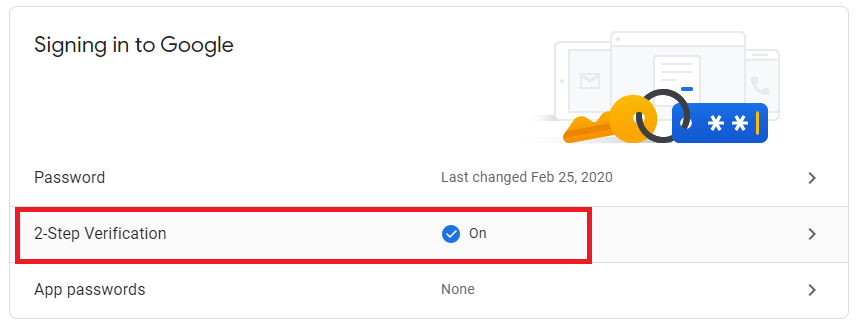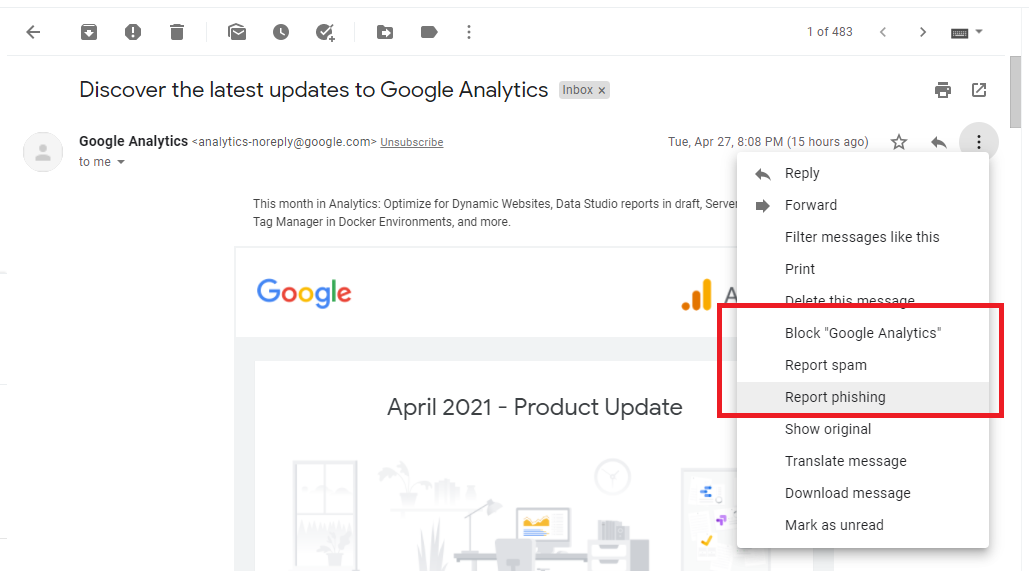Wie sichern Sie Ihr Google Mail-Konto im Jahr 2022? - Best Practices für E-Mail-Sicherheit

Online-Betrügereien sind so alt wie das Internet selbst und haben sich im Laufe der Jahrzehnte weiterentwickelt. Hacker und Cyberkriminelle probieren immer neue Techniken aus, um Benutzer dazu zu bringen, ihre wertvollen persönlichen Informationen preiszugeben. Einige der häufigsten Hacker-Versuche drehen sich um das Eindringen in E-Mail-Dienste wie Gmail.
Alle paar Monate erlebt Google irgendeine Form von groß angelegtem Hackerangriff, und die Situation war 2021 nicht anders. Ganz zu schweigen davon, dass täglich Hunderte, sogar Tausende von Menschen ihre Konten kompromittiert bekommen. Aber obwohl dies eine besorgniserregende Statistik ist, gibt es einige Dinge, die Sie tun können, um Ihr Gmail-Konto zu sichern. Hier sind die besten E-Mail-Sicherheitspraktiken, die Sie 2022 anwenden sollten, um die maximale Sicherheit Ihres Gmail-Kontos zu gewährleisten.
Wie sichern Sie Ihr Gmail-Konto vor Hackern?
Online-Bedrohungen und Gmail-Kontoverletzungen sind kein Spaß, und Google nimmt sie sehr ernst. Aus diesem Grund hat es ein sehr robustes Sicherheitssystem aufgebaut, auf das Sie sich verlassen können, um Ihr Konto vor E-Mail-Sicherheitsbedrohungen zu schützen.
Dieses System beruht auf mehreren Facetten, die Sie berücksichtigen und umsetzen müssen. Mit diesem Gedanken im Hinterkopf, hier ist alles, was Sie über die fünf besten Methoden wissen müssen, um Ihr Gmail-Konto vor Hackern zu schützen:
1. Verwenden Sie ein starkes Passwort
Alles beginnt mit einem starken Passwort. Leider übersehen viele Online-Benutzer oft die Bedeutung eines guten Passworts und entscheiden sich für Bequemlichkeit statt Sicherheit. Dies ist eine sehr schlechte und potenziell schädliche Praxis. Wenn Sie sicherstellen möchten, dass Ihr Passwort so stark wie möglich ist, ist es am besten, den Richtlinien des National Institute of Standard and Technology (NIST) zu folgen. Werfen wir einen genaueren Blick auf die wichtigsten NIST-Passwortrichtlinien:
- Länge über Komplexität - Es ist allgemein akzeptiert, dass ein komplexes Passwort deutlich sicherer ist als ein weniger komplexes. Allerdings zeigen Ergebnisse, dass die Passwortlänge viel bedeutender ist als die Komplexität. Aus diesem Grund empfiehlt NIST keine Richtlinien zur Passwortkomplexität. Stattdessen empfiehlt es, Passwörter mit mindestens acht Zeichen zu verwenden.
- Keine periodischen Zurücksetzungen - Die Idee hinter periodischen Zurücksetzungen besteht darin, unbefugten Zugriff auf ein Konto zu verhindern, indem der Benutzer aufgefordert wird, sein Passwort alle paar Monate zurückzusetzen. In Wirklichkeit kompliziert diese Praxis jedoch nur die Benutzererfahrung und erhöht die Wahrscheinlichkeit eines Verstoßes. Es ist schon schwierig genug, sich ein starkes Passwort zu merken. Es ist also immer besser, dieses eine Passwort besonders stark zu machen, als es ab und zu zu ändern.
- Keine Passworthinweise verwenden - In der heutigen überexponierten Ära der sozialen Medien teilen die meisten von uns mehr, als wir realisieren. Wenn Sie einen Passworthinweis verwenden, den ein Angreifer durch Recherche in einem Ihrer sozialen Medienprofile finden kann, machen Sie es dem Hacker nur einfacher, Zugang zu Ihrem Konto zu erhalten.
- Aktivieren Sie die Zwei-Schritt-Verifizierung - Multi-Faktor-Authentifizierung, auch bekannt als Zwei-Faktor-Authentifizierung, ist eine sehr effiziente Methode zur Identitätsüberprüfung, die es Ihnen ermöglicht, den Gmail-Anmeldeprozess noch besser abzusichern. Dies führt uns zum nächsten entscheidenden Sicherheitschritt.

2. Wählen Sie Ihre Zwei-Faktor-Authentifizierung (2FA) Methode
Das Hinzufügen der Zwei-Schritt-Verifizierung zu Ihrem Google-Konto ist ziemlich einfach und unkompliziert. Die Technologie hat in den letzten Jahren große Fortschritte gemacht und ist ein Muss für alle sicherheitsbewussten Google-Nutzer. Es gibt mehrere Arten von 2FA, die Sie einrichten können, um die Sicherheit Ihres Gmail-Kontos zu erhöhen. Die am weitesten verbreiteten sind:
- Textnachrichten - SMS-Verifizierung war lange Zeit der Industriestandard für die Zwei-Faktor-Verifizierung. Allerdings ist diese Art von 2FA mit der Zeit veraltet, da SMS-Nachrichten durch grundlegende Schwachstellen abgefangen werden können und im Vergleich zu anderen Methoden, auf die wir gleich eingehen werden, nicht sehr sicher sind.
- Google Prompts - Es gibt zwei Möglichkeiten, die Google Prompts-Funktion zu nutzen. Sie können es so einstellen, dass Sie es mit Ihrem Telefon anstelle Ihres Passworts verwenden. Alternativ können Sie es als 2FA-Methode zusätzlich zum Passwort auswählen. Wir müssen erwähnen, dass Google Prompts nur auf Mobil- oder Tablet-Geräten verwendet werden kann.
- Authenticator-App - Es gibt viele Authenticator-Apps, aber Google Authenticator ist die beste auf dem Markt. Sie ist einfach, grundlegend und relativ übersichtlich. Angesichts dessen stellt sich die Frage – kann die Google-Authentifizierung gehackt werden? Wenn Sie sich darüber Sorgen machen, gibt es nur eine 2FA-Methode, die sie übertreffen kann.
- Sicherheitsschlüssel - Hardware-Schlüssel sind immer die sicherste Option in Bezug auf 2FA-Sicherheit. Sie sind mit Blick auf Anpassung und Benutzererfahrung erstellt und kombinieren oft mehrere Funktionen und Kompatibilität mit verschiedenen Geräten. Zum Beispiel kann der Hideez Key Promo Ihre Anmeldeinformationen auf Knopfdruck speichern und automatisch eingeben, Einmalpasswörter generieren und den Prozess der Zwei-Faktor-Authentifizierung nahtlos und intuitiv gestalten.
3. Kümmern Sie sich um die Wiederherstellung Ihres Google-Kontos
Abgesehen von einem starken Passwort und 2FA benötigen Sie auch ein System für den Fall, dass Sie Ihr Google-Konto wiederherstellen müssen. Ein gutes Konto-Wiederherstellungsmechanismus ermöglicht es Ihnen, sicher wieder Zugang zu Ihrem Konto zu erhalten, wenn Sie Ihr Passwort vergessen oder Ihr Mobilgerät verloren haben. In diesem Zusammenhang gibt es zwei wichtige Aspekte, um die Sie sich kümmern sollten:
- Telefon- und E-Mail-Wiederherstellung einrichten - Die Registrierung einer Wiederherstellungs-Telefonnummer und E-Mail-Adresse ist eine wichtige Vorsichtsmaßnahme, die jeder Gmail-Nutzer treffen sollte. Es ist immer eine gute Idee, diese Wiederherstellungsdaten auf dem neuesten Stand zu halten, insbesondere beim Wechseln von Geräten und E-Mails. Wiederherstellungsdaten helfen Ihnen, Ihr Passwort zurückzusetzen, falls Sie es vergessen oder jemand anderes Ihr Konto verwendet.
Wenn Sie eine Wiederherstellungs-Telefonnummer und E-Mail-Adresse hinzufügen möchten, gehen Sie zu "Persönliche Informationen" Ihres Google-Kontos und klicken Sie auf "Wiederherstellungs-Telefonnummer hinzufügen" im Abschnitt "Kontaktdaten".

4. Betrugsversuche, Spam und Phishing-Versuche melden
Betrügereien, Phishing und Pharming-Angriffe sind eine häufige Erscheinung, mit der jeder von uns wahrscheinlich schon einmal konfrontiert wurde, ob wir es realisieren oder nicht. Glücklicherweise hat Gmail standardmäßig Anti-Malware- und Phishing-Schutz aktiviert, sodass Sie nichts Weiteres tun müssen, um Ihr Konto zusätzlich zu schützen.
Das gesagt, können einige Phishing-Betrügereien und Spam-Mails von Zeit zu Zeit durchkommen. In solchen Fällen ist das Beste, was Sie tun können, den Versuch an Google zu melden und die E-Mail auf keine andere Weise zu interagieren.
Um eine Spam- oder Phishing-E-Mail zu melden, müssen Sie zunächst auf das Dropdown-Pfeilsymbol auf der rechten Seite der E-Mail klicken. Wenn Sie aufgefordert werden, können Sie entweder die Option „Spam melden“ oder „Phishing melden“ auswählen. Dadurch wird die E-Mail automatisch aus Ihrem Posteingang entfernt und ein Bericht an Google weitergeleitet, um dessen Abwehr gegen solche Versuche zu verbessern.

Bonustipp: Wie können Sie überprüfen, welche Websites Ihre Daten verkaufen?
Google enthält eine Vielzahl praktischer Funktionen und Gmail-Tricks, die Sie für Ihr E-Mail-Konto nutzen können. Eine der besten ist die, die Ihnen ermöglicht zu überprüfen, ob Websites Ihre Daten verkaufen oder missbrauchen. Sie können dies für jeden Dienst oder jede Website tun, die Sie verwenden.
Wenn Sie dies überprüfen möchten, geben Sie den Namen Ihrer Gmail-Adresse im E-Mail-Feld und ein Pluszeichen ein und tippen Sie den Namen des Dienstes ein, den Sie überprüfen möchten. Beenden Sie die E-Mail-Adresse mit dem üblichen @gmail.com-Domainnamen.
Zum Beispiel, wenn Sie Facebook überprüfen möchten, können Sie dies tun, indem Sie die folgende Formel eingeben: yournamesurname+facebook@gmail.com. Wenn die Website oder der Dienst Ihre Informationen an Dritte weitergegeben hat, haben Sie alles direkt schriftlich auf Ihrem Bildschirm.
5. Melden Sie sich für das erweiterte Schutzprogramm von Google an
Wenn Sie einen Schritt weiter gehen möchten, können Sie die ultimative Maßnahme ergreifen und sich für Googles neues erweitertes Schutzprogramm anmelden. Dieses neue Programm implementiert exklusive Sicherheitsschlüssel für Ihre Konten und bietet zusätzlichen Schutz vor Phishing-Angriffen.
Im Gegensatz zu den meisten Sicherheitsschlüsseln, die teuer und unpraktisch sein können, ermöglicht das erweiterte Schutzprogramm, dass Geräte einen eingebauten Sicherheitsschlüssel haben. Dieses innovative Programm ist derzeit auf Android 7+ und iOS 10.0+ Geräten verfügbar. Zusätzlich müssen Sie zwei Sicherheitsschlüssel erwerben, die Sie bei Ihrem Konto registrieren.
Ist Gmail im Jahr 2022 sicher?
Die kurze Antwort auf die Frage „Wie sicher ist Gmail?“ lautet - ja, es ist sicher. Die längere Antwort lautet - Gmail ist immer noch der beste E-Mail-Dienst in der Branche und tut alles, um seine Benutzer vor äußeren Sicherheitsbedrohungen zu schützen. Noch wichtiger ist, dass es Ihnen als Benutzer praktische Werkzeuge und Mechanismen zur Verfügung stellt, die Sie nutzen können, um die Sicherheit Ihres Kontos zu maximieren und sich zu schützen.
Wenn Sie sich die Zeit genommen haben, alle unsere Tipps zu lesen, wissen Sie jetzt mehr als die meisten Gmail-Benutzer. Falls diese Seite bei Ihnen noch einige unbeantwortete Fragen hinterlassen hat oder Sie mehr darüber erfahren möchten, wie wir Ihre wertvollen Daten sichern können, kontaktieren Sie uns jederzeit.
Oleg Naumenko ist CEO und Gründer von Hideez. Er ist spezialisiert auf passwortlose Authentifizierung, FIDO2-Schlüssel und Zugriffsverwaltungslösungen. Dank seiner umfassenden Erfahrung im Bereich Informationssicherheit unterstützt Oleg Unternehmen bei der Umstellung auf eine passwortlose, Phishing-resistente Mitarbeiterauthentifizierung.



